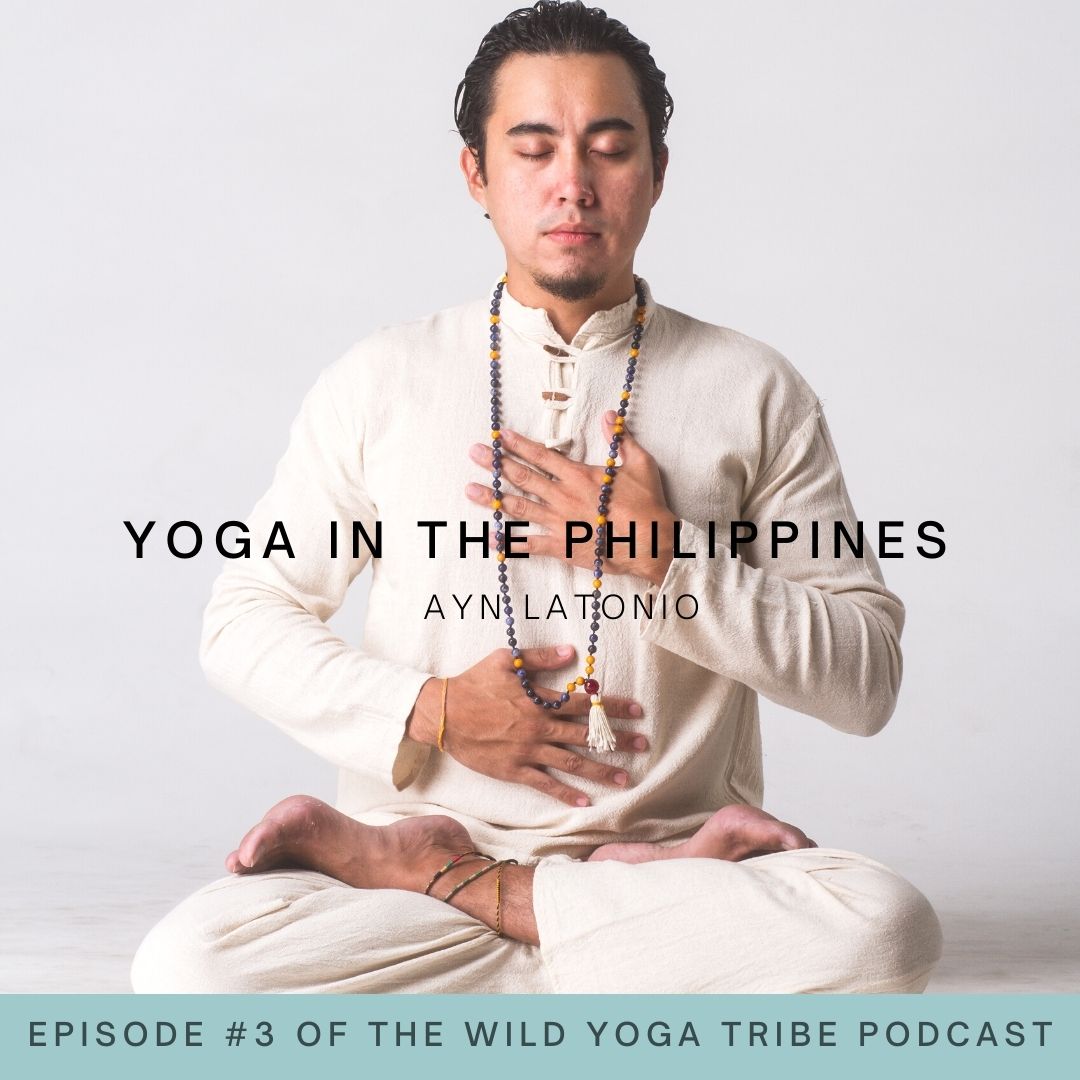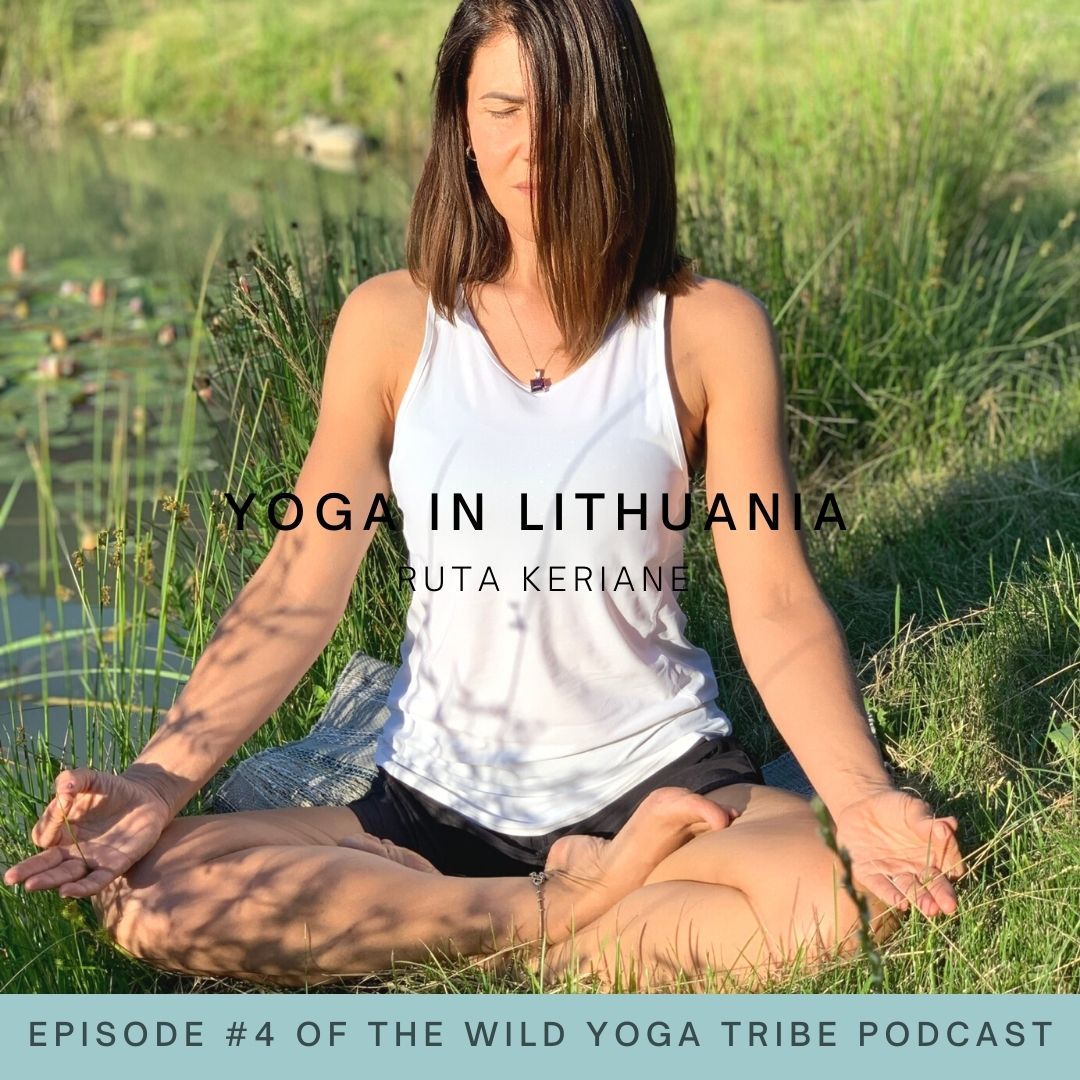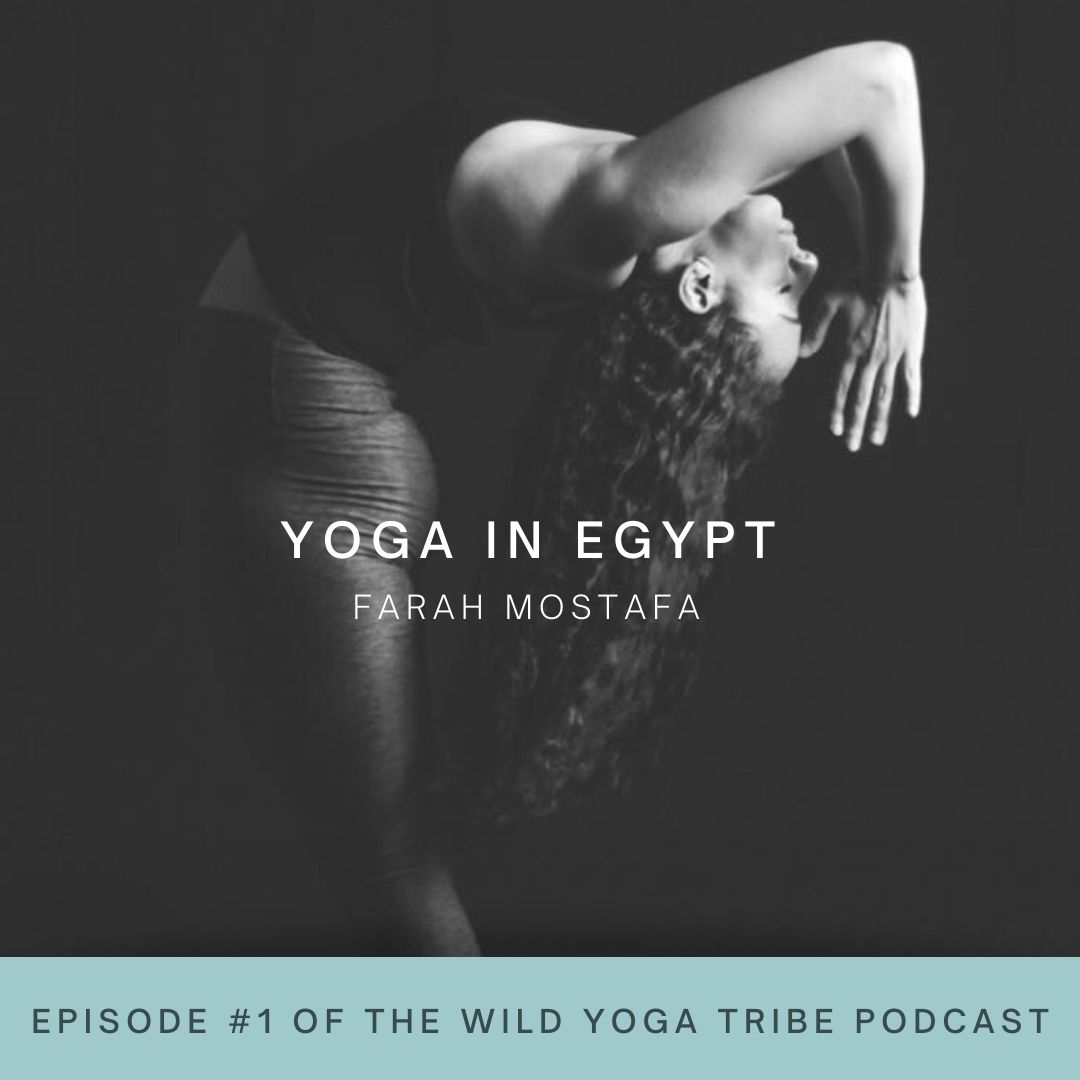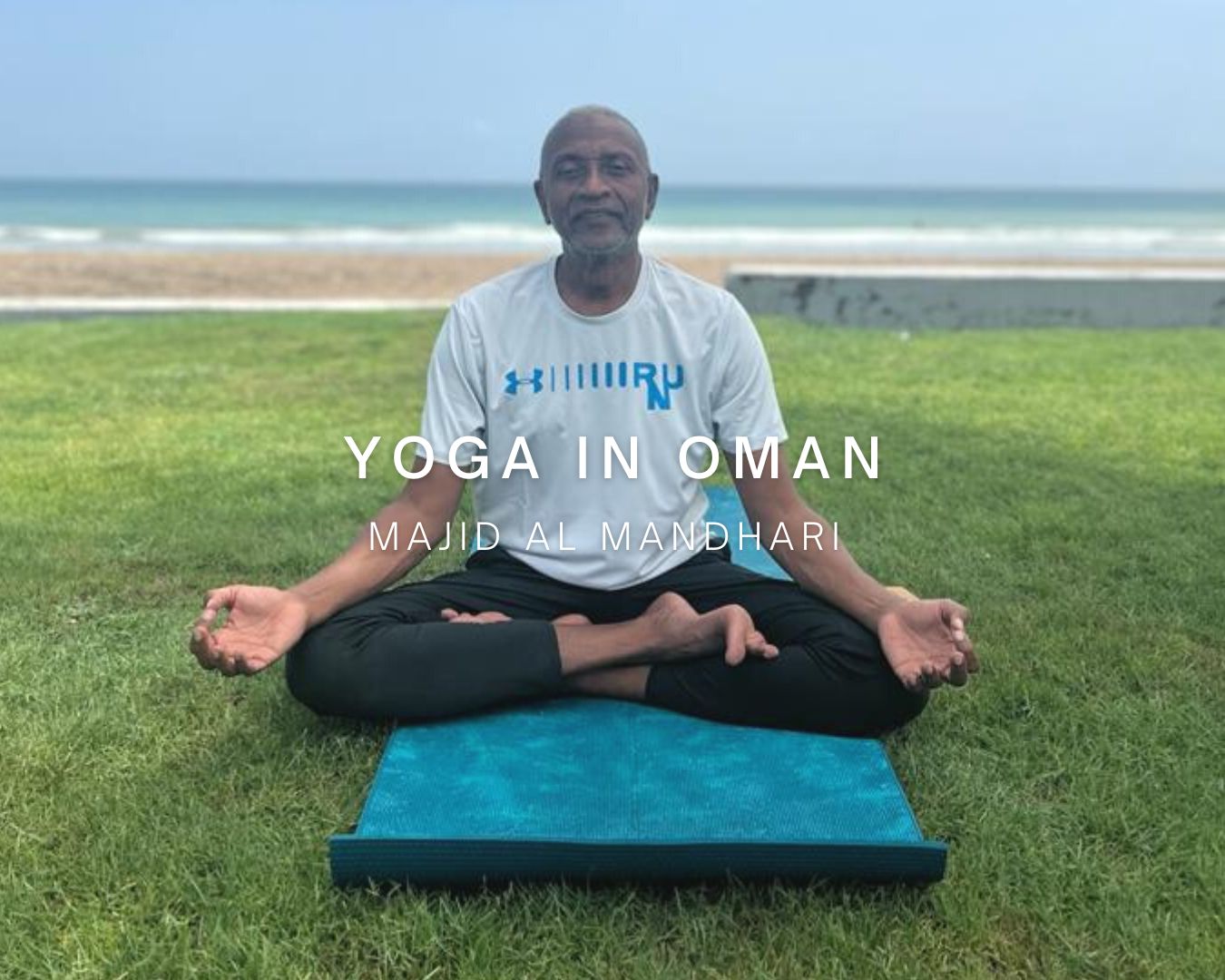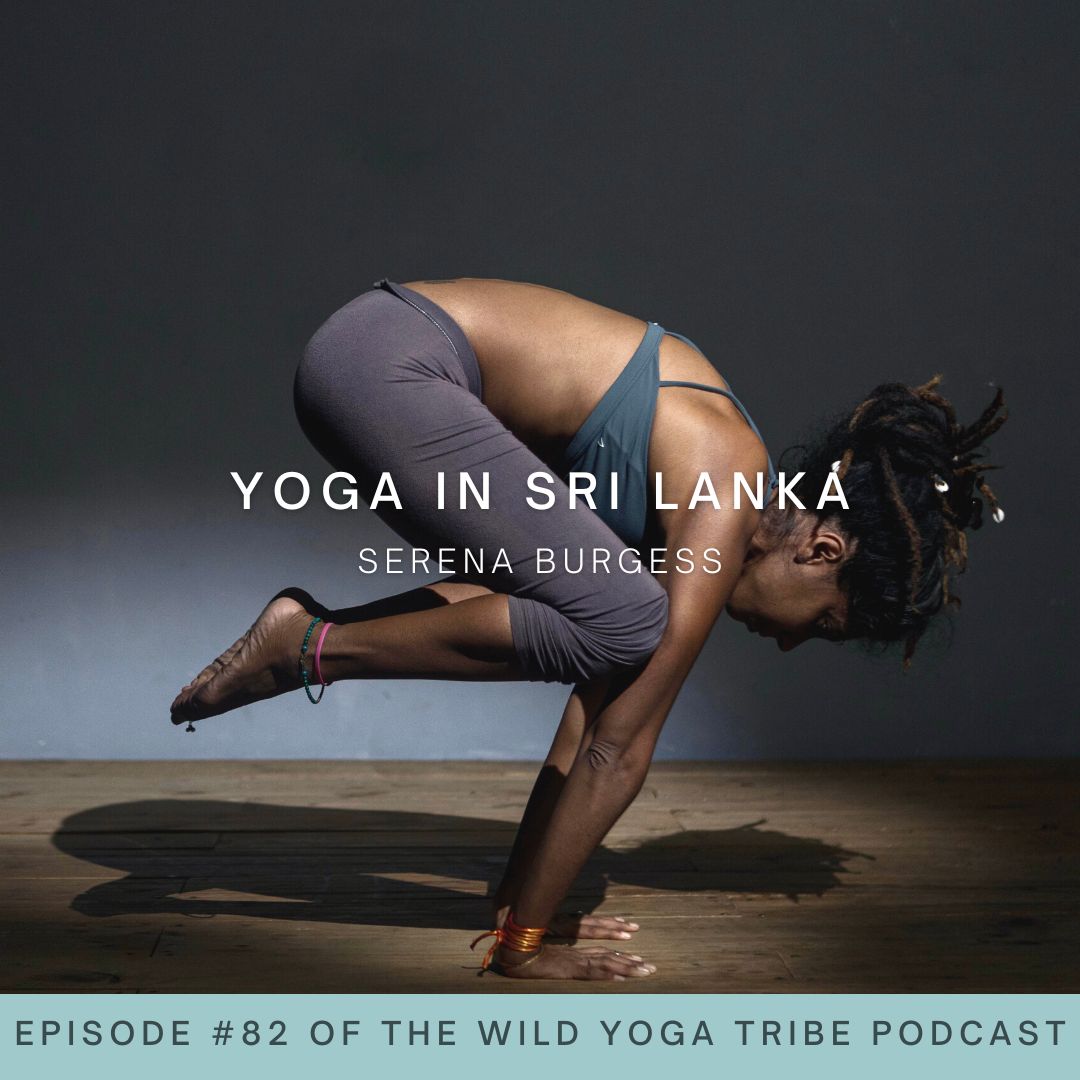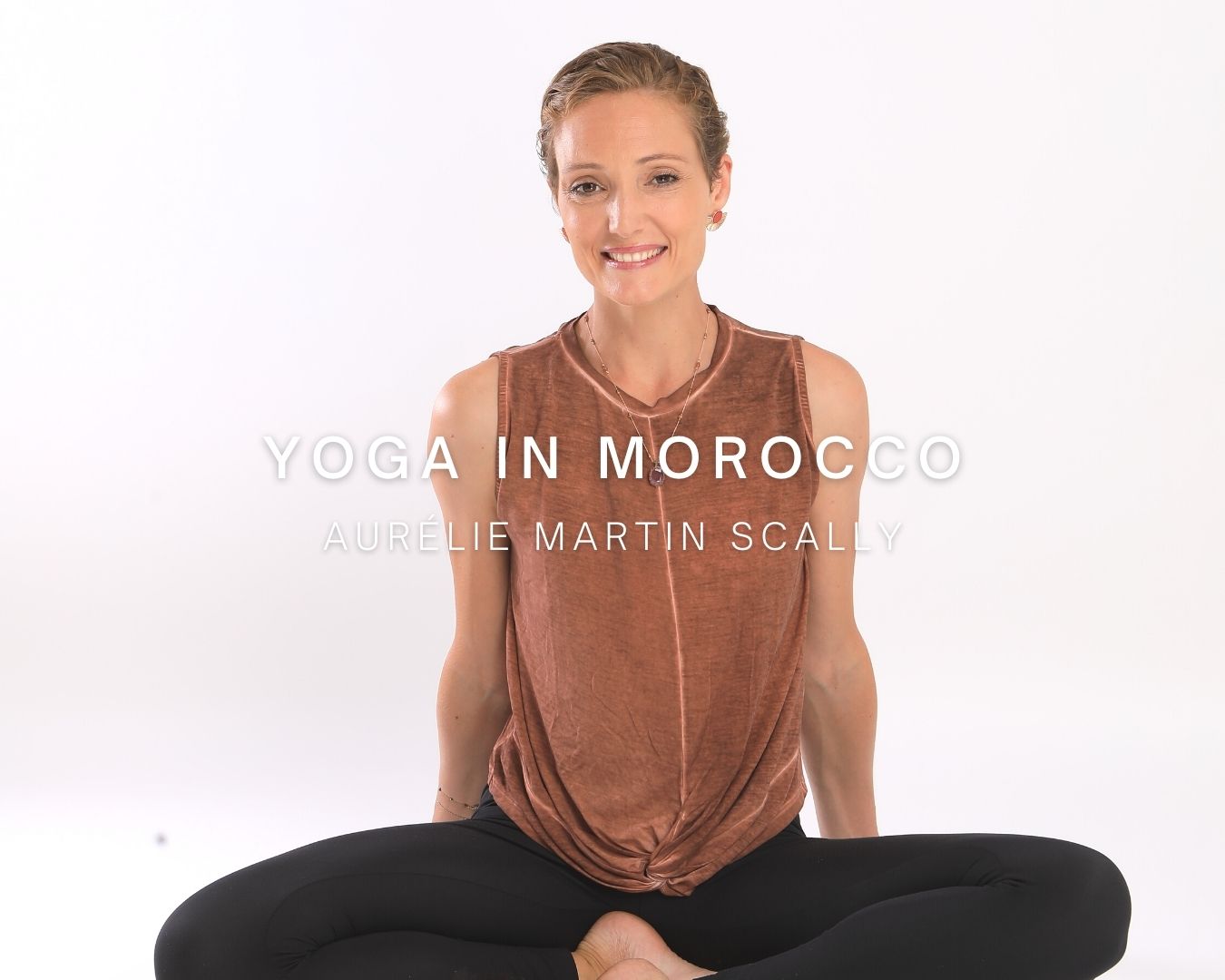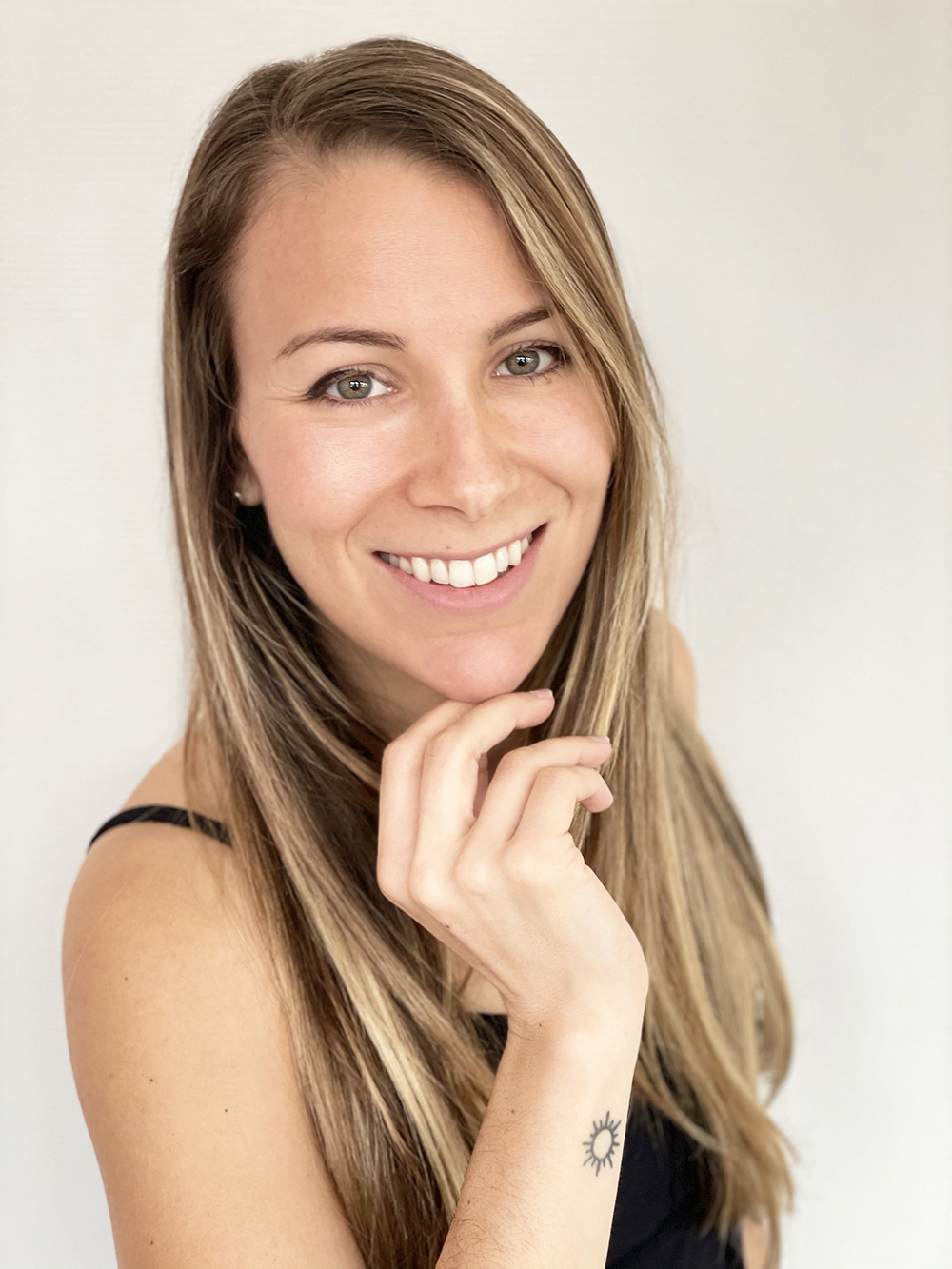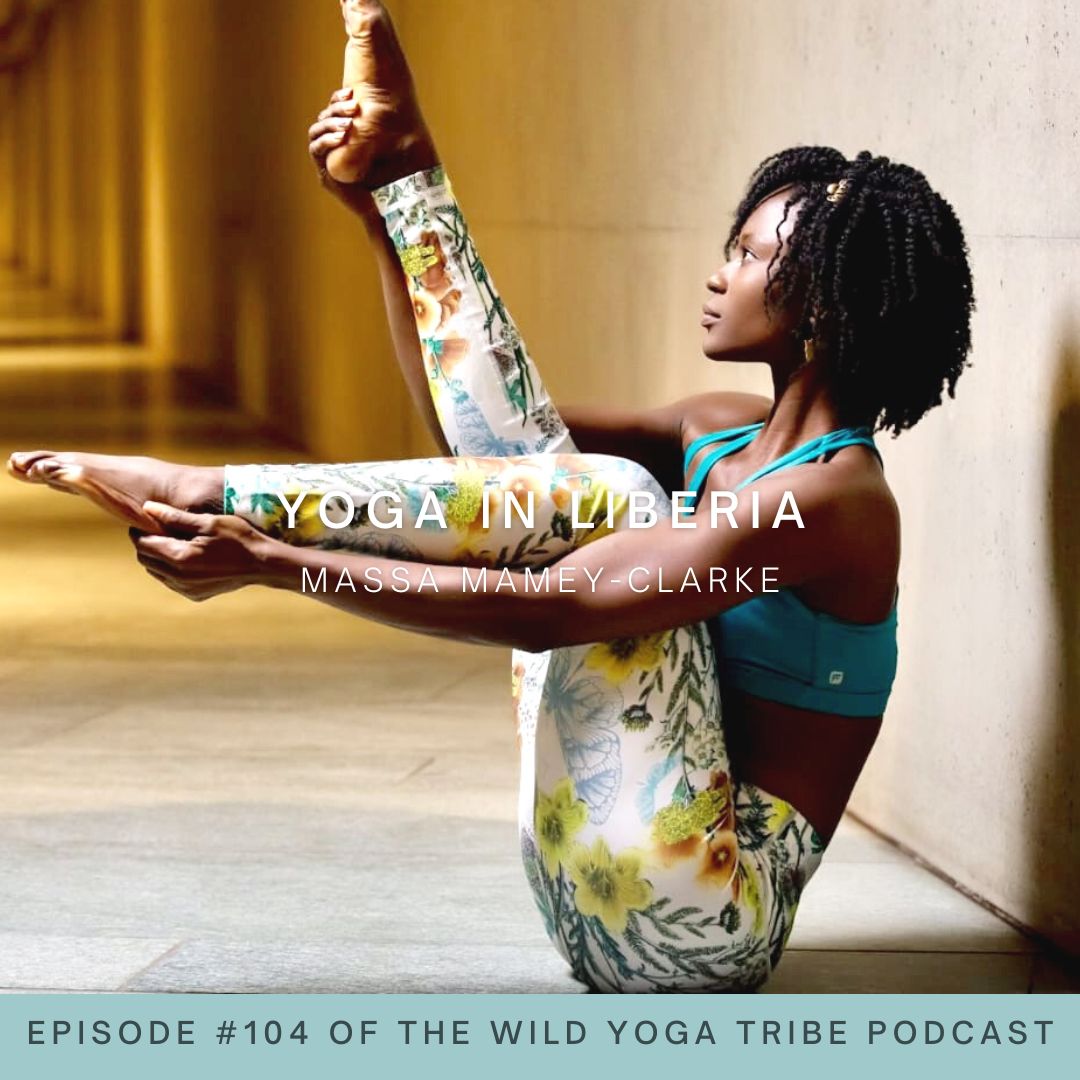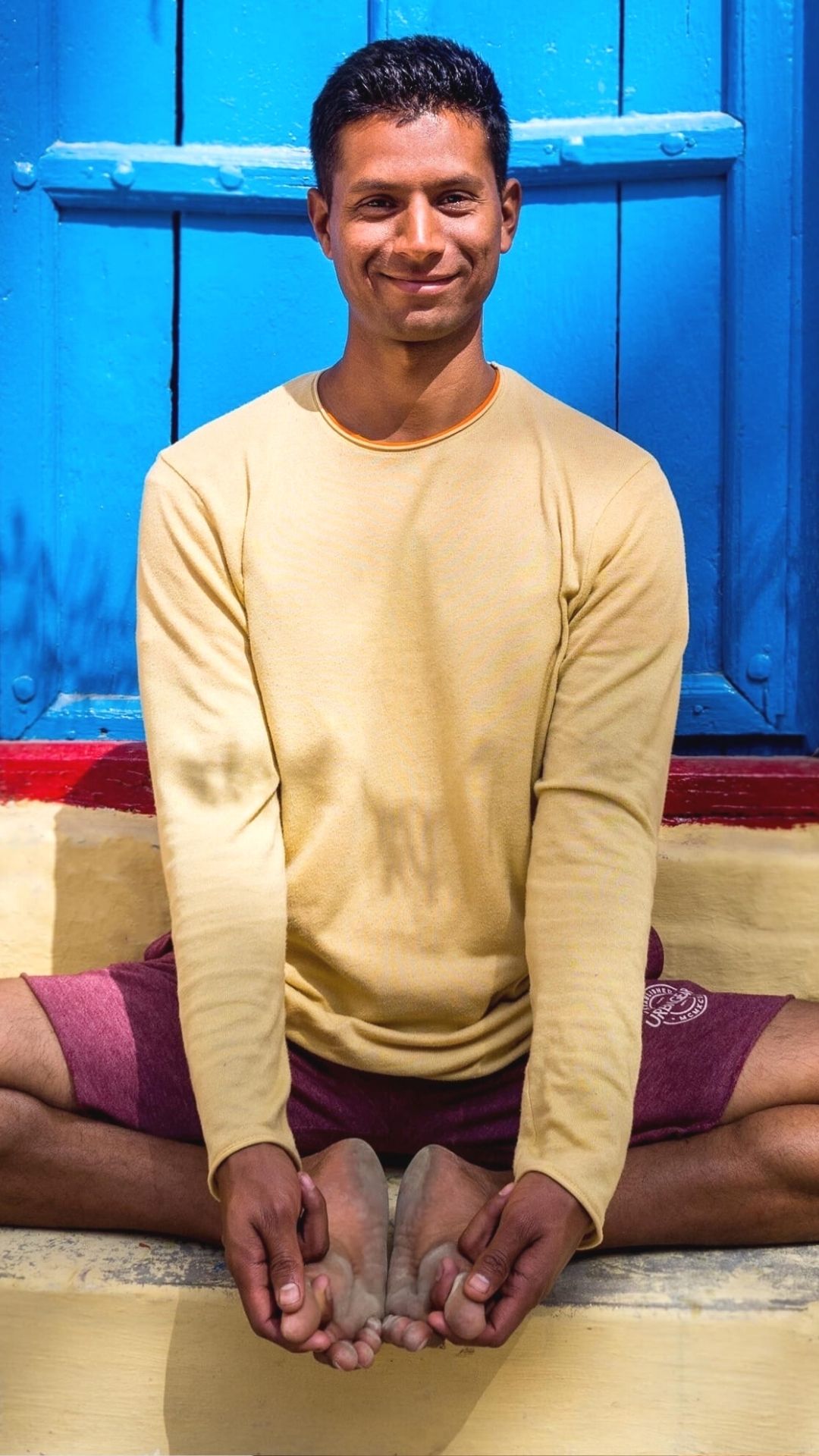
EPISODE #2 – YOGA IN INDIA
Meet Hemant Singh
Meet Hemant Singh, a yoga teacher from Rishikesh who teaches us all about yoga in India. Hemant dives into what seeking yoga on a different path looks like. Welcome to yoga in India!
Wild Yoga Tribe Podcast Episode #2 – Yoga in India with Hemant Singh
Hemant Singh is the founder of Punyah Yoga, a leading yoga teacher training school in Rishikesh India.
I first took classes with Hemant in Rishikesh in 2018, and continued to take a daily ashtanga course with him for nearly a month. I was struck by the strength of his teaching and by his presence in the shala. He has a keen eye for the tiniest details of each asana and his presence makes you know that he is always watching each infinitesimal movement you make. I certainly progressed in asana practice under his teachings.
I returned to Rishikesh in 2019 and continued to take classes with Hemant, and completed an Ashtanga alignment and adjustment course with him. We have kept in great touch over the years, and I now am a yoga nidra teacher at Punyah Yoga’s online teacher training courses.
Tell me more about Hemant Singh
Hemant firmly believes that one has to be strongly passionate about learning yoga in order to reap and experience the benefits of the path of yoga. He has practiced under the guidance of many teachers around the world including Prahlada Ji, Yogi Kamal Singh, and Vijay Mehra Ji. He considers Yogi Kamal Singh his Guru in the journey to Ashtanga Yoga and continues to pass on his teachings through Punyah Yoga School. Hemant’s classes follow the traditional Ashtanga Yoga Method, as it is taught today, with the particular emphasis on discipline being the first and foremost foundation of a Yoga practice.
I was delighted to have Hemant on the Wild Yoga Tribe podcast, to share his philosophies on yoga with you all, dear listeners.
What you can expect to learn from conversation with Hemant Singh on this episode of the Wild Yoga Tribe podcast:
I’d like to share with you a few of my favorite moments from the episode that went deeper than just talking about yoga in India and what yoga in India is like. These were moments where I felt like Hemant really touched on some profound wisdom about the path of yoga.
- What yoga is like in India?
- How is yoga different in India than in the West?
- The many branches of yoga
- The relationship between the student and the guru
- The definition of yoga
- What seeking a deeper yoga path looks like
- Going past the body and mind connection
Favorite Quote from Hemant Singh
“All the elements to touch the roots to the tree, these are the branches— asana, pranayama, Bhakti, dyana, yoga nidra, philosophy— if all these branches, all these elements meet correctly then yoga starts to happen.”
What’s in the Yoga in India episode?
Feel like skimming?
The many branches of yoga
The relationship between the student and the guru
What seeking a deeper yoga path looks like
Going past the body and mind connection
Read your own book first!
Connect with Hemant Singh and Punyah Yoga
https://twitter.com/punyahyoga
https://www.facebook.com/PunyahYoga/
https://www.instagram.com/punyahyoga/
https://www.youtube.com/channel/
UCHoLTtbjDc5bSZwkDHRGsPw
Want more?
https://wildyogatribe.com/thepodcast/
Everything you need is just one click away! Check out all the resources here: https://linktr.ee/wildyogatribe
PODCAST TRANSCRIPTION
Read + Reflect + Respond
Wild Yoga Tribe Podcast Episode #2 – Yoga in India with Hemant Singh
Lily: 00:00:05
Welcome, welcome, welcome to the Wild Yoga Tribe Podcast. I’m your host, Lily Allen-Duenas. Together, we’ll talk about the world of yoga, and we’ll talk to people from around the world. Join us for authentic conversations about the global yoga ecosystem, and we’ll cover yoga philosophies and methodologies, along the way. Inhale, exhale, we’re about to dive in.
Lily: 00:00:34
Hello, hello, hello! Welcome to the Wild Yoga Tribe Podcast. My name is Lily Allen-Duenas and I’m here today with Hemant Singh, the founder of Punyah Yoga. Hermant Singh is my own yoga teacher in Rishikesh, he is fantastic. I met him back in 2018, and I went back to India to Rishikesh in 2019 for more courses. I did an Ashtanga alignment and adjustment course with him, as well as doing daily Ashtanga classes. So as I said, Hermant Singh is the founder of Punyah yoga, a leading yoga teacher training school in Yoga Shala in Rishikesh. Hermant firmly believes that you have to be passionate about learning yoga in order to experience the real and true benefits of yoga. Hermant’s classes do follow the traditional Ashtanga method, with particular emphasis on discipline being the first and foremost foundation of the yoga practice. So, thank you Hermant for joining me today.
Hermant: 00:01:34
Thank you, Lily. Thank you for inviting me. It’s an honor to be with you today.
Could you just tell us how you got started doing yoga?
Lily: 00:01:40
Thank you. So, I was wondering, Hermant, could you just tell us how you got started doing yoga?
Hermant: 00:01:47
Yes, sure. I was introduced to Yoga with a Shivananda practice, and my sister Proba, she used to learn yoga in Shivananda, and that time I used to play cricket and I injured my back, very badly. So, I was looking to get, not the treatment, the cure. So, she advised me that, why don’t you go and do yoga classes because yoga can help you relieve any pain, whether it’s physical or mental. And that’s how my journey started and she put me in a beginner’s yoga course. It’s for two weeks with Shivananda, so I just joined, like you know, regular classes in Delhi. So, yeah, it was May 2011 when I started my journey with yoga. It’s been 10 years since I’ve been on it. And I’m teaching and guiding people.
How would you describe yoga in India?
Lily: 00:02:48
That’s wonderful. So what do you feel like yoga in India is like? How would you describe yoga in India?
Hermant: 00:02:55
Definitely. When you call the word yoga, it naturally resonates. And you know, it talks about the land of India. You know, whenever yoga comes… and in India, there are lots of states. Every state has a unique taste of yoga. And since I belong from Uttarakhand, which is a land of gods. So here, yoga which is not only Asana, or Prana, or Bhakti. It is naturally inbuilt in people’s, you know, day to day life. So it varies. I would say, in India, from place to place, and it has many many branches, first of all. All the elements touch the roots to the tree you know it, these are the branches like Asana, Pranayama, Bhakti, Jnana, Yoga nidra, Philosophy. If all these branches, all these elements, meet correctly, then yoga starts to happen.
Lily: 00:04:02
I love that you talked about how all the roots, when all the roots are there, all the branches grow and they’re all connected because I do think that’s a very important gift. When you go to India and you learn yoga in India and get to study there, that’s something that you tap into the roots. That’s the birthplace of yoga, it’s where yoga originated so I think yoga in India feels so much more powerful and authentic and important to go to that root source, would you agree?
The birthplace of yoga
Hermant: 00:4:34
Definitely. If we see… Yoga is a union. Right? Yoga is done to know yourself. What is this self? You’re getting to know your soul basically, right? By conquering the unnecessary activities of body and mind. If these things are met correctly when your body and mind sync correctly with your soul, you get to know your true behavior. You get to know why you have arrived on this earth. There is a certain purpose for everyone to arrive on Earth. That is the highest purpose of yoga. Now, to dig that purpose to go to the roots, people take many things. They take meditation. They take teacher training courses. Some people like philosophy. Some people like yoga talk, some people like to explore yoga, how they feel, they should, right. So it’s, I would say it’s a journey. And it’s very important that we do not get lost between the body and the mind only. We need to find… We need to have one strong calling which is called, “why are we here?” “Who am I?” “What is my real purpose?” Then, you can really go deeper into your own roots. And from there, what comes out, you will get to know how life progresses further.
Lily: 00:06:13
That’s very true… that we, it’s so individual, and it’s… I love how you said that we all have to do this, our own way, whether it’s Bhakti, Yana yoga, or if it’s yoga asana philosophy, it’s all our own individual path to follow.
Hermant: 00:06:37
Exactly, yes.
How do you feel that yoga in India is different from yoga, we’ll say, in the USA?
LiLy: 00:06:39
So my question for you. Maybe it sounds a little basic, but I was wondering how you feel that yoga in India is different from yoga, we’ll say, in the USA? Do you think the teaching styles are different or do you think that the classes are very similar? I would just love to hear some comparisons or contrasts from you.
Hermant: 00:07:02
It might sound funny but I’ve never been to America so I do not know the difference between yoga in America and yoga in India.
Lily: 00:07:10
Well I know that you studied in London, so maybe yoga in the UK or yoga in the West, we’ll say just a general umbrella term.
Hermant: 00:07:20
In my own experience, I’ve been to Bali, I’ve been to Thailand, I’ve been to Turkey and saw yoga there. I should say that whoever is really seeking the yoga practice, right? Rather than becoming a teacher, or rather just thinking, “I go and taste Indian culture,” or “I go and travel,” I take, teacher training course or a particular course. If you do it this way… And there is no deeper calling in you, you will only get to taste the upper layer, you will not go deeper into your lowest layer. So, in the West, even not in the West, even in India, people do yoga, just for a little purpose, right? If your purpose is just to be flexible, for an example, right? You don’t want to go deeper, you only get to see, “I am flexible, and that is yoga for me.” Yoga has a deeper meaning, right? So, it’s not only the West also in India and I say, every person who has the fire to know themselves, you know? They should go beyond the Asana practice, to beyond the illusions of the mind, which I see sometimes is a little more in the Western because lots of identification with the body and mind is there. Right, so if you only identify yourself as body and the mind, then I would say you are still stuck in that process, which happens a lot in the Western countries. If you see it, the deeper meaning of yoga is you are neither body you are nor mind. But actually, the mind is not a leader. It can never be a leader, it can be a great servant to, to achieve the highest consciousness, or to achieve God, or in order to achieve the realization.
The only obstacle which comes between your single soul to the Supreme Soul, is the mind. So this mind and the body are the biggest obstacle, which happens to be. How do you say, which happens to be seen by more investing people that they are only attracted to a good and flexible body, and a mind. But these two are some stepping stones you know towards achieving the highest. Once you have realized that you are not the body, you are not the mind because if you are living very consciously, if you simply see the behavior of your body and the mind, they keep changing with situations. If you do yoga for a week, you are tight. If your body’s tight, your mind becomes tight. If your body becomes tight, people say I’m not feeling good. Right, so this feeling generates from the mind goes to the body, and now the body listens to the mind. All the organs are connected with the mind. Right? So, how bad the mind is, the body follows. So even if you don’t do yoga for seven days or a month, you are tight. You should never, never ever reach to a point where you are telling the senses of the mind you are tight, because your highest goal is to achieve the self which is here, right here, the body and mind are a rented place for the soul. So they are not real. So once people in the West or even in India, they realize they can achieve their highest potential in life, and they can even go through the Moksha and Mokhti and liberation in their life and they can live with self detachment.
Lily: 00:11:14
I love how you said the body and mind are rented space for the soul. I think that is very profound and very true. It’s part of that learning process that occurs in yoga and meditation, about using the body and mind as a bridge to connect with our higher consciousness or to reach for something outside of ourselves that is divine energy, the Atman to the Brahman. So why do you think in the West, then it’s so easy for us just to identify or connect, just with the body and mind, especially in yoga?
The body and mind in yoga
Hermant: 00:11:49
So when Art was created, the supreme energy, you call it, or you say the Brahman or you say God Shiva is same, or you say Jesus, for them, everybody is equal. Everybody has a capital city, to be zero, to become 00 is a, is a state, which is very close to give you a liberation, first of all, right? But as soon as we are growing so much into materialism, technologies, right? And lots of layers are attached to our mind, right? Our mind has been protected by many layers, it’s a layer of making money. Right? It’s a layer towards getting attracted to somebody else; it’s a layer towards eating good food. What you like you’re doing too much, right? So it’s not only in the West. As each country becomes civilized, these layers are natural, to come to a person. Even in India, even in people nearby me, I see they are far away from knowing who they are, they even don’t know the mind. Mind is playing with them. So, if you talk about the West, first of all, people who are getting knowledge from India, or Indonesia, some part where yoga has been widely spread, they need to really go deeper and they need to take loads of time getting to know themselves. Right?
Once you get to know yourself, these layer effects are already very very less. For example, if Lily gets to know herself so well, a person comes to Lily. Right? We’ll get cured. We’ll get peace. That is the first sign that you know yourself. He will see that you have an aura. This is one of the elements that a person realizes. He has realized his soul, he has realized the highest version of yoga, and he is living in this material world. Right? If this feeling you get from your teacher. I say stay there. Right? But if you only get the vibes of a teacher that it’s just a business model. It is just, you know, Asana practice. He is not taking me deeper into my problems. For example, somebody suffering from grief. Right? You just don’t give him Asana. If somebody has a very strong imprint of fear in their soul, you cannot just tell them to do this practice, or that practice. First and the most important thing in the West, I see that this is lacking there. People are only understanding the body and mind conditions, but truly, they are not going to the deepest root of the individual, what they are suffering from. Once you understand what it is causing, then only you can provide a remedy or a cure for a medicine. So that is very important. And if your teacher does not have that quality, you may like yoga for one month, two months, one year two, year three years, slowly injuries are there, right? Confusions are there, doubts are there, you’re still not becoming ready. I would say the person who wants to deliver real yoga has to go through lots of efforts, a lot of ayasana. Then, it is possible that a person will come to me. If I’m not able to help them, this course has no value. And if, even after doing this course people are confused, the course has no value. People are still sick. They have no value. You know there’s no value of course. So this is, this is my point of view, this is how I see yoga as, you know. And this is how I would like to teach. If somebody asked me how it’s supposed to be, this is my way of understanding the Western and Indian culture. And if they can adapt this practice, I think we don’t need to teach thousands of people, we don’t need to train 10,000 graduates. If you just cure one person, you change that one-person’s life. It is enough.
What is your definition of yoga?
Lily: 00:16:27
It is that giant ripple effect of changing one life and then all that comes from that — all of the ripple effects. I agree, absolutely agree with you there. It’s important not just to focus on the masses or the numbers, it’s very important that we see each person come to us as teachers is a gift and is someone that we should help to solve their individual problems or provide them exactly what they need to go deeper. Because as you said, it takes a lot of effort. This isn’t something that’s easy, it’s not just going to one yoga class at the gym once a week and feeling like, “Oh, I’m a yogi. That qualifies me as a yogi now”. I love that we’re talking so much, Hermant, today about the whole path. You’re mentioning Sadhana and we’re talking more about all the work that goes in internally to understand our habits or behaviors or patterns of our mind, and of our energy so that we can kind of get to a subtler and subtler places, not these course energies of these course layers, as we say. So I know we’ve kind of touched on it so far, but what would you say is your definition of yoga?
Hermant: 00:17:46
It’s a very short and precise answer. I would say go deeper in your soul, and ask your soul: what is your purpose for renting my body? Right? And what are the karmas left to perform in this world? And that is yoga for me.
What do you feel that yoga has taught you, so far?
Lily: 00:18:03
And what do you feel that yoga has taught you, so far? I mean I know we’re both still on that journey of course but what has yoga taught you?
Hermant: 00:18:13
Well, I still think that there can be many answers to it. But what has actually brought me into the yoga practice, and how I see my life after doing 10 years of yoga is that I would like people to help to the best of my skills. So naturally, if a person comes, I want to work on them. Right? I want them to get to their highest potential, to get to know themselves, and within a month of this practice I want to give them as much as they can absorb so they do not become confused. They are fearless. They are doubtless. They are crystal clear in the minds. They understand what their intentions are, what their duties are (that we call Dharma), and what their actions towards the duties are (which is karma). And that is… would be my highest goal as a practitioner of yoga.
How do you know what to teach a new student?
Lily: 00:19:14
And so when a student does come to you in a TTC or in just a normal Ashtanga class at Punyah yoga or any of your courses you offer, how do you know how much to teach them or so that they’re not getting confused or overwhelmed as you just mentioned?
Hermant: 00:19:31
It’s a very good question, Lily. “How to have an eye to see that the person you are going to give is ready?” You see how empty he is in his mind, how easy that person is, how simply understand my simple commands. Right? How simply he observes me, how simply he listens to me, how simply he wakes up in the morning. These are the few signs you know, if there is complexity. If there is laziness, these two people you can never teach. It’s very straightforward but complex. If a person is complex, he makes simplest things complex, that’s his, that’s his main feature. If a person is lazy, that’s his main feature, he will make things lazy. So, people, I would say, need to come here with simplicity. Because here, the way I teach, the way I further develop my teaching, is very simple. So simply, I would say probably his behavior, and I also have ability to see how much you know he’s good in his heart, and that really matters to me. So, if the heart is really clean, very original, it’s very easy. If the heart is not clean, not original, then the person has to go through some purifications, then the length of achieving self is higher.
Lily: 00:21:01
So it’s through observing? You just kind of notice, pay attention and also check in with their level of presence? Kind of what they’re bringing to the classroom, how they’re observing or how they’re watching or how they’re performing certain activities or things? It’s through your process of just kind of observing their mind, their body and their energy, it seems like all three. Oh and their heart, so four.
Hermant: 00:21:25
Correct, yes. In my Guruji, I just do not even see the person. If I just say a person’s name is John Cartier, he will understand everything about that person. So he has reached that level. Just John Cartier, all the data comes to him. But I am not at that level. So, I’m also going through some techniques like Shivananda used to watch a person from bottom to top, top to bottom. Get to know everything about that person. Until we are at that level, what you said, observation, simplicity, his behavior and his heart are few things that I watch after. And then, I understand that person is ready to deliver.
So if a student does walk into your classroom, what is one thing, the most important thing you think you need to teach them?
Lily: 00:21:17
Alright, so if a student does walk into your classroom, what is one thing, the most important thing you think you need to teach them?
Hermant: 00:22:27
In India we worship everything. We worship our door; we worship our motorbike. We worship our Yoga Shala. We worship trees, plants because we see that they all are the messages from the highest energy. So the person who walks in, first of all, should respect the space and the highest quality of a yogi is to be timeless. He does not care about the time, or this clock, which is manmade. So, in order to make the person timeless, I need to see that he is on time, to be timeless. So first, respect the space, and second, to be on time. Then, I really like that these two qualities are met before I start teaching them.
Lily: 00:23:16
So is there something about yoga philosophy or the history of yoga or yoga psychology or methodology that you think is just key, just vital for students to understand? No matter if they’re a beginner, intermediate, or advanced, is there something that you think might be missing, some elements of knowledge that you would like to share with listeners here about yoga and the paths and something they need to know?
True knowledge of yoga
Hermant: 00:23:45
Sacred books, I believe, should be learned under the practitioners, because it takes almost one life to understand one book. If you start to study on your own, there may be a chance that you get confused. You are your own book. Read that book first. So that is why, when you are under a Guru, Guru never gives you a book. Guru is a light that always shows you that you read your own book, so he reads you better. So for him, you are a book, and he lets you read your book his way.
Lily: 00:24:27
Right student, right time, right teacher. I think that is one of the most powerful kinds of knowledge or phrases that I’ve digested when I was in India. Is that when the right student comes at the right time than the right teacher will appear, you just have to be in that space and kind of having creating that space for yourself to find the right teacher, and it seems like when you’re mentioning how the guru would be treating their student that resonates as well that it’s right student right teacher right time.
The guru in yoga
Hermant: 00:24:59
Almost, I would say. This phrase needs some editing. In order to know the right time and the right teacher, the person has to be sensitive. If he is not sensitive and emotional, how would he understand it is the right time or the right knowledge or the right teacher? Right? So he has to believe in coincidences. If a person has a stone heart, he will not believe in coincidences. He believes in facts and logic. And when the truth appears in front of you, that’s the highest truth. It doesn’t have logic. So that’s why I say, do not seek the right time, the right teacher; flow, be sensitive and flow. Second, I would say in this phrase that if what you’re calling from the deepest of your heart is fiery and super strong, you become sensitive. When you become sensitive, you start to see coincidences, you start to see nature, the law of attraction, you start to see how things sync on, you know, side by side. Then the right teacher comes because now you have an insight, what is right for you. The right time comes because you are sensitive and you believe in coincidences, so you will make sense out of nothing, right. That’s also a good quality of a yogi. Even if you live far from the tree, he knows its meaning. But for a normal person, it was just a waste because it had to. So, if these things are met sensitivity, your calling, inner calling, then the right teacher, at the right time, right knowledge appears in front of you. That is my own experience.
Lily: 00:26:55
So it sounds like the right teacher, right time, right student, does need some editing to make sure that it actually is something that can benefit every person or benefit each person individually because developing that sensitivity, I think, is part of getting to know yourself better and better.
Hermant: 00:27:13
Hundred percent.
Lily: 00:27:14
Yeah, because I think we kind of run away from ourselves so much, we’re constantly trying to escape ourselves, escape our lives via you know drugs, alcohol, staying busy watching Netflix. I think we usually as a culture or just as people, we tried very hard not to be with just ourselves, we can find that very uncomfortable. And so I do feel that meditation or Asana practice or any of the limbs or practices of yoga. I find it to be just ways of connecting with yourself, getting quiet, and just being with yourself to understand yourself more.
Finding quiet in yoga
Hermant: 00:27:52
Totally, I agree with you. Like you know, we are running a gold race in this world. You know we are all gold, and we are just following the leader, and we do not know the leader. And in this gold race many, many, many things are there. So we are for money, everybody watches movies. We watch the same movies, somebody goes to PAL, we have to go to the park. Everybody eats every three hours. We have to attend every three hours. So, actually, indirectly we are pretending to pretend to be somebody else. Then, how we can go deeper within ourselves, when every day, we are trying to do everything away from ourselves. That is, that has to be uncovered. So when you lead your own life, when you know these small, sensitive and coincidences that tell us “I don’t want to run a gold race. I want to know myself, I will bring change in the world.” Only few people really are there in the world who want to make such a change. Therefore, they bring change, and then they lead the world, but the right intention has to be there.
Lily: 00:29:13
Yeah, the intention to help everyone, all living beings, should be the intention not helping yourself to achieve something for your ego. When I think you have those altruistic intentions, it helps to kind of manifest what you are seeking. It draws those energies to you when it’s not for just selfish endeavors.
Hermant: 00:29:33
Totally agree, yes. Totally agree with you.
How can people get in touch with you?
Lily: 00:29:37
Yeah, so I feel like we have talked about so many good things. Today Hermant Singh, I’m so grateful that you have taken this time to be with me today. I wanted to ask, how can people get in touch with you?
Hermant: 00:29:53
People can simply log onto our website, which is punyahyoga.com, and they can find me there. They can also go to their phone; they can go to Instagram. We are present there, as Punyah Yoga. Personally, I’m also available under the identity of Hemant_Singh06. And if you want to find me physically, I am based in Rishikesh, and Punahou. Yes, but keep me in your heart you don’t have to find me.
Lily: 00:30:30
That’s sweet. I will definitely include links to everything Hermant mentioned in the show notes, and on my website so you can get in touch with him, reach out with any questions you have. I know that he is a true teacher, and someone that is an incredible resource to tap into and to follow and to get involved with so any questions that you have, I’m sure he’s happy to answer and to connect with you on, is that correct?
Hermant: 00:30:59
That is correct Lily.
Lily: 00:31:00
Wonderful. Well, thank you again Hermant for being with me today. I’m so happy we had this conversation. Thank you.
Hermant: 00:31:06
Same here. My pleasure. And thank you for inviting me. I’m forever grateful.
Lily: 00:31:12
Thank you.
Wild Yoga Tribe Podcast Outro
Lily: 00:31:18
Thank you for being on this journey with me. It has been a privilege to be with you. I know that your time is precious and I am both humbled and honored that you chose to spend your time with me here on the Wild Yoga Tribe Podcast. As you’re on your own inner journey, remember that you are not alone. There are so many of us on this path to awakening, this path of self discovery and expansion, and we are right here, alongside you. Remember to hit subscribe so that you never miss an episode and if you feel called, please share this episode with someone that you think could benefit from it. Leaving a review would also be so appreciated. If you’re on social media, I am there too @WildYogaTribe, you can tap into all the amazing resources on my website, the wildyogatribe.com and you can meditate with me on Insight Timer and get your flow on with me on my YouTube channel, where I’ve recorded free yoga classes. If you’d like to schedule a private yoga or meditation class with me, or a coaching session, you can find the link to do so, to book in the show notes, or on my website, again the wildyogatribe.com. Thank you once again dear listener for being with me. May your day be light and bright. May you be peaceful and happy and lead on the right path, free of suffering and free of sorrow. Be well, dear one. Be well.
[End Transcription 00:32:49]
[Music Outro 00:32:49]
Copyright © 2022 Wild Yoga Tribe LLC. All rights reserved. Transcripts are generated using a combination of speech recognition software and human transcribers, and may contain errors. Kindly check the corresponding audio before quoting in print to ensure accuracy.
The Wild Yoga Tribe, LLC, owns the copyright in and to all content in and transcripts of the Wild Yoga Tribe podcasts, with all rights reserved, including right of publicity.
What’s Okay
You are welcome to share an excerpt from the episode transcript (up to 500 words but not more) in media articles (e.g., The New York Times), in a non-commercial article or blog post (e.g., Elephant Journal), and/or on a personal social media account for non-commercial purposes, provided that you include proper attribution and link back to the podcast URL. For complete transparency and clarity, media outlets with advertising models are also welcome to use excerpts from the transcript per the above.
What’s Not Okay
No one is authorized to copy any portion of the podcast content or use Lily Allen-Duenas’ name, image or likeness for any commercial purpose or use, including without limitation inclusion in any books, e-books, or on a commercial website or social media site (e.g., Instagram, Facebook, etc.) that offers or promotes your or another’s products or services. Of course, media outlets are permitted to use photos of Lily Allen-Duenas from her Media Kit page or can make written requests via email to receive her headshots folder.

